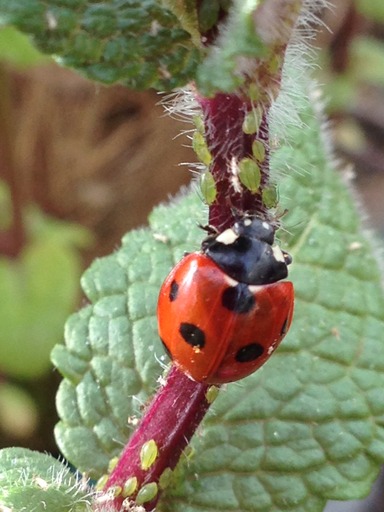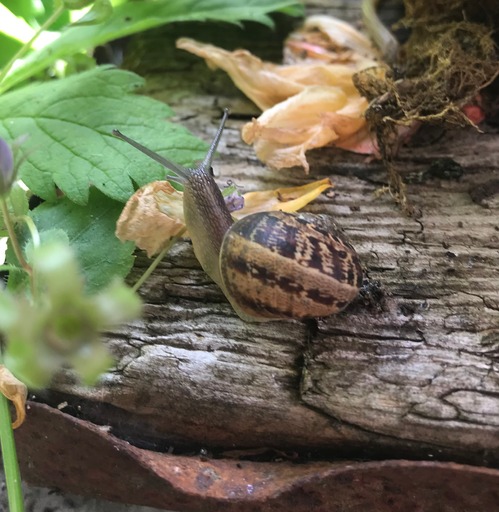
The protected environment inside a greenhouse is not just good for the plants. Jean Vernon has a few unwelcome guests to evict.
It’s spring and nature is stirring. The birds are nesting, the bees are emerging, and the garden is surging into growth. There’s that earthy smell in the greenhouse with seeds sprouting, cuttings rooting and forced bulbs and overwintered corms and plants now bursting into growth. Everything is alive at last.
Interconnectedness
The seasons are finely tuned into nature. The early emerging bees time their appearance with the right flowers in bloom to sustain them. And it’s the same with the birds and other wildlife too. As spring progresses their natural food becomes more and more abundant ensuring that each layer of the food chain has enough to sustain them so that they can breed and reproduce. I find it fascinating that ladybirds lay their eggs on emerging nettles, which are often affected by aphids, so that their larvae have plenty of food. And that many bees and pollinators evolved with their plant partners and grow and thrive together, each depending on the other.
Protected environment
But the greenhouse is a separate universe in terms of nature and of course a perfect place to overwinter and reproduce. Any creatures that can move into the warm, dry space do benefit from its protection but they also need a source of food to sustain them and the all-important water of life.
As spring unfolds my greenhouse guests are becoming apparent. And while I don’t like killing things, I do need to step up and take control before things get out of hand. There are a few invaders that need stopping in their tracks and others that simply need returning to the wild. I won’t be using pesticides in my greenhouse or garden so that means I need to employ some integrated ‘pest’ control.
Greenhouse Aphids

There has been a low level of aphids in the greenhouse all winter. In the cold it’s barely a problem and while there is little else very active in the greenhouse I did use Plant Invigorator to keep them in check. But now we’ve had a few milder, sunnier days, the plants and cuttings are really starting to grow and the aphid population has started to build. My main mode of control involves pinching out and pruning out badly affected stems and placing them outside the greenhouse. But my next battle uses a very neat and powerful weapon, the ladybirds. Ladybirds overwinter as adults hunkered down around the garden and they start laying their eggs so that the first hatch coincides with the aphid explosion. On a sunny day, talk a walk around the garden looking for the bright red ladybird livery. When I find them, I pick off the shoot that they are on, just in case they have laid some eggs there or in case it harbors some additional food and then I hotfoot it to the greenhouse. Over the last 2-3 weeks I’ve caught about eight ladybirds and they have all been placed inside the greenhouse near to the aphid explosion. My hope is that the adults feed on the existing aphids and that the ladybirds may mate and lay eggs inside the greenhouse to continue this aphid munching work.
Slugs and snails
Under the pots, beneath the self-watering platforms and around the greenhouse are a few slugs and snails. A daily inspection of seeds and seedlings usually highlights where these little critters are feeding. Sometimes it’s one snail that feeds at night but does and incredible job of pruning back new shoots and then hides away before my morning greenhouse check starts. It doesn’t usually take long to find the culprit and it’s a simple job of moving it outside into the garden or into the compost heap where it can continue its good work. I do like snails. Growing up with the children’s programme The Magic Roundabout, one of my favourite characters was Brian the snail and I can’t help giving even the most determined snail another chance. I’m not so forgiving with slugs. Often they end up in the chicken house, or if I’m feeling more benevolent then they are relocated to the compost bin. And when things really get growing I will add a sprinkling of organic Slug and Snail Control behind the planters and among the plants just to keep things under control.
Greenhouse Whitefly

For the first time in the life of my greenhouse (twenty plus years) I have greenhouse whitefly. I’m pretty sure I imported it when I purchased some plants from a well-known mail order supplier. And actually I am quite cross about that, well, more cross with myself for not quarantining the new plants on arrival. Already these ghostlike mini-moths are lurking under leaves and building their numbers. I don’t need to put yellow sticky traps up to see whether they are present, I’ve seen them as I move among my seedlings, water my cuttings and generally tidy up. There are a few ways to get on top of greenhouse whitefly. Some involve spraying, which I don’t intend to do. I might take my trusty cordless vacuum out and dislodge the little ghosts from their roosts to ‘hoover’ them up mid flight, but honestly the best control is to employ another of nature’s predators, the parasitic wasp Encarsia. There’s no need to have meltdown at the word wasp. There are 7000 plus wasp species in the UK and Encarsia is nothing like the yellow jackets you imagine. Instead these little wasps are a naturally occurring control for whitefly. They lay their eggs in the whitefly scales and then these hatch out instead of new whiteflies. Encarsia needs the spring temperature and starts working at 10C so it’s important to wait until the temperature rises, but it is the cleanest, kindest way to get to grips with these white winged demons before they take over. For expert advice on effective biological control and green gardening, visit www.greengardener.co.uk and for more information on Encarsia check out the website here: https://www.greengardener.co.uk/product/encarsia/
It’s a programme approach, which is a very clever solution, the easy to hang cards, which contain tiny developing Encarsia wasps arrive every 7 days for several weeks, depending on the programme you choose. The Encarsia population builds over time, which gives better control.
Greenhouse whiteflies are a particular problem on tomatoes, so I need to get the whitefly under control before my tomatoes establish.


